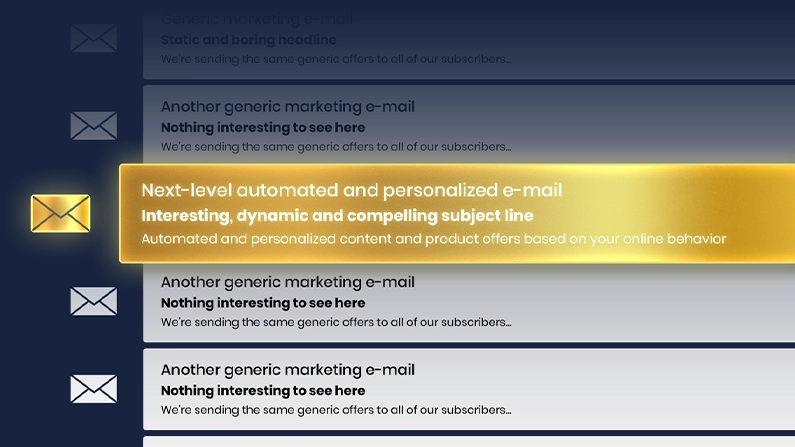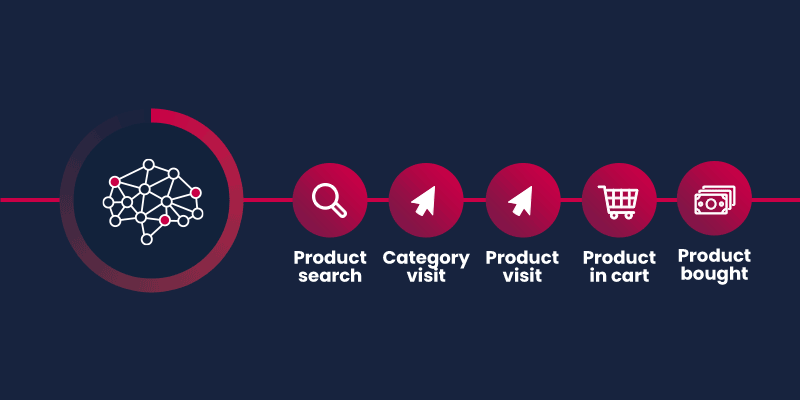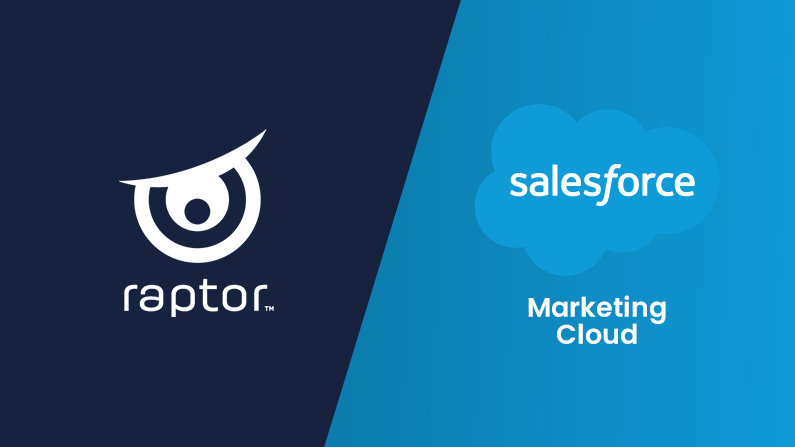Email Personalization – Raptor vs. Platform
Aug 06, 2020 | E-mail Triggers

Your average subscriber receive a lot of emails, from many different companies every day and a lot of them are probably your competitors.
How do you make sure that they buy from you?
Personalized emails is the key to stand out, once you have convinced them to open your email.
Your subscribers has become used to personalized emails, and expect that they are relevant and based on their interest and behavior.
Your email platform should not also be your personalization solution
Most email platforms offer some sort of “personalization” option in their suite. This function can be used to customize your email content to different segments of your choice.
Segments, however, are not the ideal way to personalize your emails, since they are based on group behavior and not the individual.
There is nothing wrong with segmenting subscribers, we encourage you to do so and nurture them through a well-planned email flow.
But, when it comes to the personalization options offered by the email platform, they are often not that advanced.
For some, a personalized email is one that starts with “Hi [first name]”. We are not here to tell you that you should not use dynamic tagging and call people by their name. But that’s the simple and basic stuff, that any given email platform can do.
If you want to make an impact on your email performance, you should start by getting to know every last person on your email list including their interests and preferences.
Why you need a best of breed personalization solution and how it works
Raptor tracks the subscriber’s behavioral pattern on your website, which then can be used to personalize the products and content of the subscriber’s email through a module.
Whenever the subscriber opens an email, a signal is sent to Raptor’s database to check if there is any previous behavioral patterns from that induvidual subscriber to display in the email, depending on which module is chosen for the specific email campaign.
If there is a behavioral pattern, the products that will be recommended are based on previous behavioral data.
If the user is unknown, or if we do not have any previous behavioral data on a product, we use backfilling to look into the category structure.
Through relevant and related categories, we can recommend relevant products and content without vast amounts of user data.
If a subscriber has no previous behavioral data from your website our fall back logics will still be able to show relevant products to the subscriber.
Usually, a module consisting of either bestselling or trending products is the best fit for these subscribers.
Modules
A module is a collection of algorithms containing customer data, that serve a specific purpose such as generating personalized recommendations.
Raptor modules are the recommendation blocks you can build and implement in your emails. Each module has an underlying API method and algorithm. Modules return data. They can return JSON, XML, CSV, HTML or even images.
Personal recommendations
Generates targeted personalized recommendations, displayed as product images, to feature in your newsletters campaigns and automations.
Popular products from a given brand/category
Generates a list of products within a given Brand or Category. The recommendations will be personalized if the subscribers are known, if not our backfilling will choose the most relevant products.
Trending products
Generates a list of all products, that are currently trending on the website, to feature in newsletters to users. You can determine the period. If you have a short period, the module will be very dynamic and vice versa if the period is long, it will be a static module.
Platform and technology agnostic
Platform and technology agnostic means that the business needs and demands of each specific client, with different systems and platforms, enhances our ability to support a wide variety of different organizations.
At Raptor we have a variety of technology integrations, that enables any client to merge their data into our recommendation-engine such as POS data, which can enrich the recommendations.
Likewise, we have a lot of platform integrations and our open API makes it possible to make integration into any email platform.
Dynamic and real-time updates
Delivering updates in real-time means that customer- and subscriber data is processed within milliseconds, to always show the most up to date and relevant products in your emails.
As a user’s behavioral patterns change, so should the products in your emails and it has happen instantaneously to match the user’s expectations.
If you are not updating your product selection in real-time, but in batch, you are going to end up with a problem. If users have additional interactions and behavioral patterns in the time between an email is sent, and the time they decide to open the email, these will not be taken into consideration. This is because the point in time where the batch was updated could be a long time ago. If you update in real-time, this won’t be a problem and you don’t have to worry about not having the most updated data in your emails.
This is also very important in terms of price/stock changes. If a specific product during the time of being placed in the basket suddenly changes to be on sale, the discount could have expired, or the product could go out of stock before the user has had time to finish the purchase.
Example:
You send a newsletter campaign out Monday, but the subscriber opens it Friday.
If your product modules/recommendations aren’t dynamic and updated in real-time, all the user’s behavior is not registered and thereby updated in the email.
If the user has shown interest in a specific pair of sneakers from Nike on Tuesday, this product won’t be shown in the email when the subscriber opens it Friday. Furthermore, if the price has changed Tuesday it should also be the updated price in the email when it is opened on Friday.
Avoid the manual process of choosing products
Instead of guessing which products could be relevant for your subscribers, you can instead let your subscribers’ actions determine which products should be shown in your emails.
No matter the email subject, the modules will make sure that there always will be relevant products tailored to the individual in the emails you send.
Data from multiple data sources
To deliver the best recommendations, you should integrate customer data from multiple data sources. The more data you can use as a determiner of which products should be displayed to each user, the more precise recommendations you can display to the individual subscriber.
If you are a B2B with online commerce, your customers often have an account for their specific company. Likewise, they often have an account card/identifier, which they use to make purchases in your retail store, which means that their offline transaction data can be connected with their online data, which then can be used to make better recommendations online.
Example:
If your company both has a commerce site and a retail store, you can connect the user’s customer- and transaction data.
Both B2C and B2B can use this feature.
If you are a B2C e-commerce business an easy way to do this is by having a “loyalty club”, so whenever a user purchases anything in your retail store and use their membership card, the data will be saved and you can use this in your online recommendations, both through your website, emails and all your other channels.
If you can identify your users offline (loyalty club, e-mail, or with third-party integrations like StoreBox, etc.), then we can combine online and offline data.
Example:
If you are a B2B with online commerce, your customers often have an account for their specific company. Likewise, they often have an account card/identifier, which they use to make purchases in your retail store, which means that their offline transaction data can be connected with their online data, which then can be used to make better recommendations online.
Know your subscribers before they become one
With our tracking script, we know subscribers before they decide to become a subscriber.
Before a user becomes a subscriber, they might have already purchased a product and visited your site multiple times. Even though a user has just become a subscriber, you can use these previous behavioral patterns, to make accurate recommendations in your emails.
Why is that an important feature?
If you do not start collecting data on your subscribers before they become one, it will take time to gather enough data to be as accurate as you would like in your recommendations. The more data you have, the better and more precise recommendations, you can present to your subscribers.
Key takeaways
The email platform’s personalization options are very limited and basic, which is fine if you want to use dynamic “personalization” tags such as “[first name]”.
But if you want to use advanced personalization you need to look outside your email platform and integrate a third-party vendor like Raptor to deliver a fully personalized customer experience in your emails.
- Email platforms have trouble delivering advanced personalization, which means that a third-party vendor is needed to deliver truly personalized emails
- Dynamic and real-time updates are a must if you want to deliver truly relevant emails
- Avoid the manual process of choosing products for your emails and let your subscriber’s behavior determine the product selection
- Integrate data from multiple sources to deliver more precise and better recommendations
- Know your subscribers before they become one so their previous behavior can be used from the moment, they decide to become a subscriber.
Related Content
You might also like
Do you transform your Black Friday encounters into lasting relationships? Or do you let this annual...
Learn More
Sustainability and e-commerce. To many, they’re considered close to mutually exclusive. But they...
Learn More
If you're familiar with price drop triggers, you already know how effective they are at converting...
Learn More
If you’re a seasoned e-mail marketer, you might think you know everything you need to know about...
Learn More
Is this how you create newsletters too? If you work in e-commerce, you might recognize this routine:
Learn More
E-mail marketing is an important way to stay in touch with your customers. But it can also be a...
Learn More
Are you looking to take your e-mail marketing to the next level and increase conversion rates? Then...
Learn More
Raptor is proud to present our most advanced recommendation module to date. Find out what the new...
Learn More
The Black Friday season is upon us, and when working with e-commerce it’s essential to prepare for...
Learn More
Is your brand using Salesforce Marketing Cloud? And do you want to deliver the most relevant and...
Learn More
Let us show you what you can achieve with premium personalization


A Raptor expert can share more about the product and answer any questions you have.











